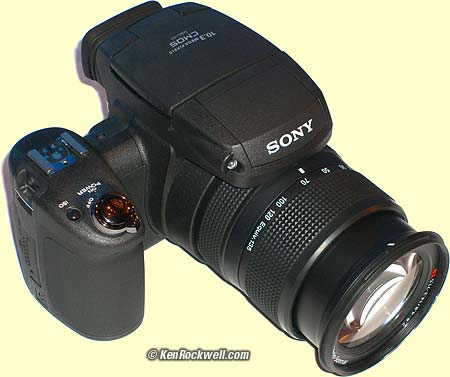|
|
Sony
DSC-R1
©
2006 KenRockwell.com
Sony: A9 III A1 A9 II A9 A7R V A7R IV A7R III A7 IV A7 III A7R II A7S III A7c A7 II A6600 A6400 A6100 A6000 ZV-E10 RX10/4 RX100/7 RX100/6 Flash Lenses
I'd get it here, here or here. Click to enlarge.
I'd get it here, here or here. Click to enlarge.
INTRODUCTION
The Sony DSC-R1 was introduced September 8th, 2005 in San Diego, California.
I got to try a prototype. From what I saw I strongly suspect that it's image quality will easily outperform every other fixed-lens digital camera, bar none.
Of course I'd never buy one myself, because as a fixed-lens camera it's slower than a glacier compared to any true SLR, like the less expensive Nikon D50 or Canon Digital Rebel.
If you want an EVF (electronic viewfinder) camera this seems easily to be the very best for image quality. It does this easily due to the huge full-sized image sensor, the first ever in this class of camera. Just be forewanred that it lacks needed features like Shade White Balance and is too slow to shoot moving people, children, pets or sports.
It's a huge improvement over the obsolete DSC-F828 and every other fixed-lens EVF digital camera.
It has 10 Megapixels and will sell for $999.95. Shipping is expected by November 25th, 2005.
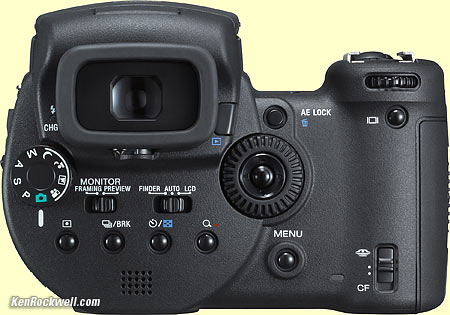
Sony's DSC-R1 is a breakthrough in EVF point-and-shoot cameras because it has a full-sized sensor. By full-sized sensor I mean 21.5 x 14.4 mm, which is full size for digital SLR cameras. It's not as big as the old 35 mm film aperture was. More here on sensor sizes. Canon has a great explanation of why a bigger sensor leads to better images here. Personally I prefer real SLR cameras like the Nikon D50 as I explain at the end, but for people who love EVF cameras this is the one.
For the first time you can get real DSLR image quality at full ISO in a fixed lens camera. More about these two classes of cameras here. As an EVF P/S, as opposed to a true DSLR, it's probably not suited for fast action or fast kids. It is very well suited to landscapes and anything that holds reasonably still. Not having a reflex mirror allows lens designers the freedom to place the rear of the lens close to the sensor if they choose. The DSC-R1's lens gets as close as 2 mm to the sensor. Having no flipping mirror it's quieter than an SLR.
The full-sized sensor gives the DSC-R1 great sensitivity, depth-of-field control and low noise. The 10 MP spec isn't that significant as you can read at the Megapixel Myth.
Few people understand why the big sensor is a big deal. Pixels on a sensor collect photons like buckets collect rain while sitting in a rainstorm. The bigger the bucket, the more rain or photons you collect. When you have a big sensor with big pixels collecting more photons you get much more sensitivity to light. This increased sensitivity gives you higher ISO speeds and lower noise.
Higher ISO speeds lead to much sharper photos because you can use faster shutter speeds to eliminate motion and hand-held blur. The DSC-R1 is 5 to 8 times as sensitive as other EVF cameras.
The ISO range of the DSC-R1 is 160 - 3,200 and the range of other fixed lens cameras is only 50 - 400. Other fixed-lens cameras that claim higher ISOs deliberately blur the image to blur the effect of noise at ISOs like 800 and 1,600. I see none of that with the prototype DSC-R1; all it's images were sharp even at ISO 3,200!
You get less noise because the camera doesn't need to amplify the signal as much as cameras do with the typical tiny sensors. Noise is constant and caused by the random motion of electrons. Greater signal and sensitivity means you see much less of that noise due to the lower levels of amplification required inside the camera.
Sony makes a big to-do about the DSC-R1 having "Full-Time Live Preview," exactly like every other point-and-shoot digital camera and unlike a true DSLR. Personally I prefer a real DSLR with a real ground-glass finder over the grainy, jerky image on the DSC-R1's peephole LCD, however for $999 complete with a great lens and stellar image quality the DSC-R1 ought to be the first choice for people in the market for this kind of camera.
Unlike a true DSLR the Sony DSC-R1 has a rotating top LCD for live composition regardless of camera position. You can photograph from angles impossible with a true SLR and still see what you're doing.
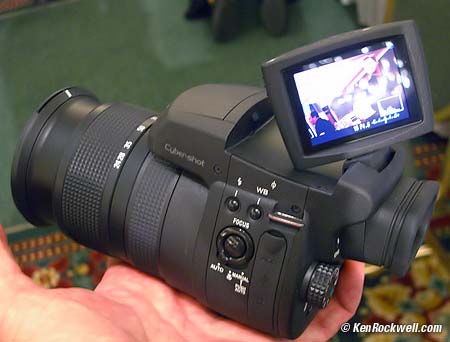
Clever monitor swings at almost any angle, including flush with the top.
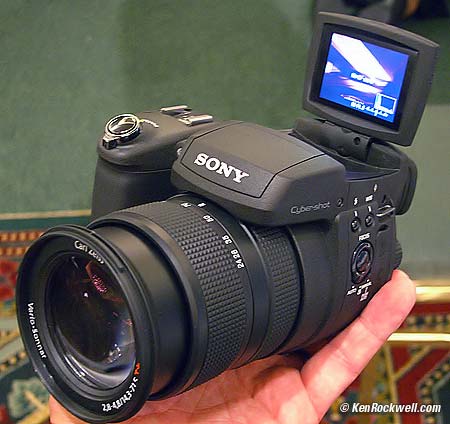
The DSC-R1's very wide lens makes it especially ideal for real estate people. Most fixed lens cameras only go as wide as the equivalent of 35 to 39 mm on a 35 mm film camera. The DSC-R1 goes as wide as the equivalent of 24 mm. The only other fixed-lens camera of which I know in the US market that goes this wide is the Nikon 8400, however I found the Nikon 8400 very noisy due to it's typically tiny sensor and the 8400 had a lot more distortion than the superior Sony DSC-R1.
SPECIFICATIONS
10 Megapixels: 3,888 x 2,592 pixels
21.5 x 14.4 mm CMOS image sensor. Sony makes this sensor themselves. They also make the sensor for the Nikon D2X. I know Sony makes great sensors: I used to be an applications engineer working with them over ten years ago.
ISO 160, 200, 400, 800, 1,600 and 3,200. Sony's printed specs have been changing around each day. The prototype I used had all these speeds.
Lens: 5x zoom. 14.3 - 71.5 mm f/2.8 - 4.8. It gives angles of view similar to a 24 - 120 mm on a 35 mm film camera. Warning: the "135" notation on the zoom ring refers to 135 size film, a crafty deception. The lens only zooms to the equivalent of 120 mm. It has the Carl Zeiss brand name printed on it. Minimum aperture: f/16.
Real, direct mechanical zoom ring, just like a real camera. It's not a crappy motorized zoom like most point-and-shoots.
67 mm filter thread.
5 AF zones. The DSC-F1 does not focus on the direct optical image as a DSLR does. The Sony DSC-F1 instead focuses by looking for contrast in the video image coming from the image sensor. It can't focus in real time, just like every other camera in this category.
White Balance: Auto, Daylight, Cloudy, Fluorescent, Incandescent, Flash, One Push (White Balance Adjustment: -3 - +3, by step). Sadly it is missing the critical Shade setting. This is important to me; I'd have to trick and dedicate the manual one-push setting to this where I'd strongly prefer a dedicated Shade setting. The Shade setting is a professional secret in getting great skin tones and vivid landscapes in every outdoor light condition except direct sunlight. More here about white balance.
JPG and RAW modes. Unknown if any software other than Sony's can read the RAW files. Sony software runs on windows in addition to Mac. I always use JPG. JPG only has two quality settings.
Three color spaces: sRGB and Adobe RGB and an extra-vivid sRGB. I'm going to try it in vivid sRGB first.
Built-In Flash. Also a hot shoe for the dedicated HVL-F32X and HVL-F1000 flashes.
No movies and no sound. Too bad; other EVF and fixed lens cameras can do this.
LCD Screen: 2.0," small by 2005 standards, but it flips around for freedom in composition. There also is another LCD visible through a rear peephole.
There is no true through-the-lens viewfinder as claimed by Sony. You're just looking at a small electronic screen through a peephole, not ground glass through a reflex mirror as on a true SLR.
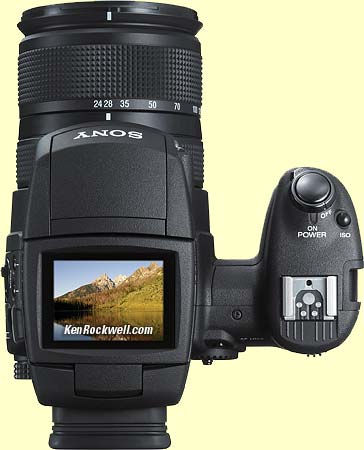
Grid lines for the LCDs. These help keeping things level.
Shutter: 30 seconds - 1/2,000. Bulb to only three minutes. Sync speed unknown; probably pretty good due to a presumed electronic shutter.
Takes CF I and II cards, Microdrives and memory sticks up to 4 GB.
Sony uses the phrase "Advanced Gradation Control System (AGCS)" to refer to their auto contrast control. These go a long way towards making great images, if and only if the designers programmed the firmware well. It takes quite a bit of wisdom to do this well, and done right it can be amazing. Ideally you'll never even know it's working. When it's done well you just get great photos. I have to play with this and let you know. I love the way it works in my Nikon D70.
Battery: InfoLithium NP-FM50 1180mAH. It has the usual excellent "minutes left" indication unique to Sony. Rated up to 500 shots by Sony.
USB 2.0 connection.
Included Accessories: NP-FM50 InfoLithium battery, AC-L15 adaptor, USB and video cables, shoulder strap, and software CD for Mac and windows.
Extra Accessories:
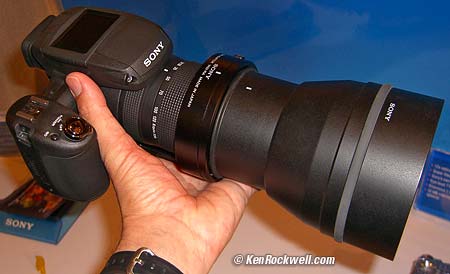
VCL-DEH17R 1.7x tele-end converter mounted with VAD-RA adaptor
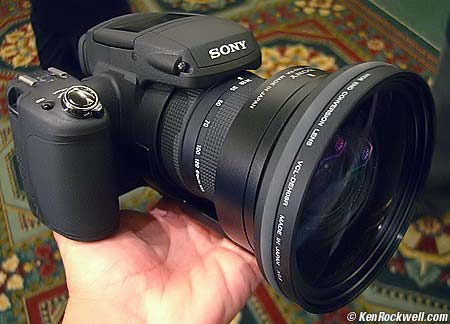
VCL-DEH08R 0.8x wide-end converter mounted with VAD-RA adaptor
You have to hand it to Sony for making some very crazy, specialized and dedicated accessory lenses. These are expensive, big and heavy. Before you consider them I'd suggest just getting a Nikon D50 and some interchangeable lenses instead, since a true DSLR and dedicated interchangeable lenses will weigh a lot less, be easier to use and work better. You can't zoom through these Sony converters.
The1.7x tele converter only works at the longest zoom setting, so you have to pull off the converter to zoom back out. It gives you the equivalent of a 200 mm lens on a 35 mm film camera. This is equivalent to a 135mm lens used on most true DSLRs. If you zoom out with the tele conversion lens you just get a circular image surrounded by black. I'm unsure what happens if you zoom through the wide converter. That's why I hand it to Sony to go ahead and design something as special interest as these.
To use either lens you also need a prosthetic VAD-RA adaptor which attaches to the bottom of the camera and provides a sturdy enough framework to hold either huge conversion lens.
The 0.8x converter gives a view similar to a 19 mm lens on a 35 mm film camera, or a 12 mm lens on most DSLRs.
Canon, Nikon and others make dedicated ultra wide zooms for their SLRs. For $500 you can get a Tokina 12-24mm f/4 ultrawide zoom lens for any true DSLR, which is a much better idea since it's smaller, goes wider, and zooms. I don't see that you can zoom with the Sony wide-end converter, thus its name. On the other hand, if you are more intrepid than I and really go for this humongous wide converter, it's pretty good as converters go. Distortion of the combination as I tried on a prototype camera isn't bad at all. It required about a +4.82 setting in Photoshop CS2's distortion correction. It has a relatively complex signature and doesn't completely come out.
It's laudable that Sony offer you the option getting the equivalent of a 19mm lens with this converter.
PERFORMANCE
I got to shoot with and analyze images from a prototype because it mistakenly was thought to be a final production model. Whoops! What I saw isn't necessarily representative of what the final product will be, and if I had known it was just a prototype I wouldn't have analyzed any images I made. Since I did, the good news is that the image quality is great even on the prototype! I suspect that will easily be the world's best fixed-lens digital camera, bar none. The big lens and big sensor let it do this easily. From what I saw there simply is no comparison to any other fixed-lens camera. Explanation? No other fixed-lens camera has a sensor this big.
ISO and Noise (as seen on a prototype camera)
Excellent!
Noise is invisible at ISO 160 and 200. You really have to know how to look for it at ISO 400, otherwise it's also invisible. At ISO 800 it's very minor and visible only at 100%. At ISO 1,600 it starts to get noisy, and still extremely usable for the conditions under which you'd use ISO 1,600. I've shot hand-held under full moonlight with ISO 1,600 film and an f/1.4 lens, for instance. ISO 3,200 is grainy as you'd expect.
The more great news is I saw no deliberate blurring; it stays sharp unlike many other cameras which deliberately blur the image to hide noise at high ISOs. This is superb performance! This is about as good as the best DSLRs and worlds better than any other fixed-lens, small sensor digital camera. Use it up to ISO 800 any time, and use ISO 1,600 and 3,200 if you need them. ISO 1,600 on the Sony DSC-R1 looks about as good as ISO 200 or ISO 400 on every other fixed-lens camera.
Lens (as seen on a prototype)
I love that the zoom ring is a real manual mechanical zoom control for instant, continuous adjustment. The ridiculous motorized zooms on fixed lens cameras usually only stop in discreet steps. Also the zoom ring of the DSC-R1 is very well laid out, there is no bunching up of focal lengths at either end as happens with many other zooms. It's always easy to get to the exact setting you want.
The distortion is reasonable at every zoom setting. It should be trivial to correct in Photoshop CS2, although is is slightly complex to it won't come out completely at the wide end if you are deliberately looking for it.
14.3 mm (24 mm eq.) It has very little barrel at the widest setting, which is better than most zooms, even on DSLRs. The lens on this prototype DSC-R1 only required a setting of +2.37 in PS CS2's lens distortion correction filter. The distortion of the DSC-R1 was a little bit complex and not completely corrected by that filter, but it's invisible for any real use. By comparison I find the Nikon 8400 at its widest setting needs a +6 setting in Photoshop CS2's distortion correction and looks awful without that correction. The DSC-R1 looks great even without correction. It's better than any of my Nikon zooms at their wide ends!
19.3 mm (32 mm eq.) very little pincushion
29.7 mm (50 mm eq.) a little pincushion
47.1 mm (80 mm eq.) looks perfect
60 mm (100 mm eq.) looks perfect
71.5 mm (120 mm eq.) looks perfect
The sharpness looked fabulous. Let's wait for a production version for a real test.
RECOMMENDATIONS
The R1 is in a weird niche. Some people love cameras with fixed lenses, while personally I'd prefer a real SLR like the Nikon D50 which even costs less. For the same price as the R1 you can get a Nikon D50, a Nikon 18 - 55 mm lens and a Nikon 70 - 300 mm G lens and still have money left over! The D50 kit with just the 18 - 55 lens will be much better for action shots, like kids, than the R1. The D50 can track continuous motion like a runner coming towards you. The 18 - 55 lens on the D50 doesn't quite go as wide or as long as the R1 does. Add the 70 - 300 lens for the D50 simply because you can for less total than the R1 and the D50 setup now zooms 3.75 times as close!
Image quality of the D50 setup for most people will probably be better because the D50 is a true SLR which has faster focusing and overall operation than the R1's EVF configuration. Faster focusing in the real world, not just a laboratory, means the D50 will probably get many more photos in focus if you have subjects moving around. The D50 also has Shade White balance, lacking on the R1. I have examples here showing why the Shade setting is important.
The Megapixel number has nothing to do with image quality unless you're making prints at least a couple of feet wide. More about the Megapixel Myth here and more about the differences between EVF and SLR cameras here.
Give the Sony DSC-R1 a look if you want a fixed-lens EVF camera. I need to get more time with it. For image quality it can't do anything but dominate the fixed-lens EVF camera category. It may be a very good alternative to a DSLR for subjects that hold still.
My biggest complaint is the lack of the Shade white balance setting. This is important to me; I'd have to trick and dedicate the manual one-push setting to this where I'd strongly prefer a dedicated Shade setting. The Shade setting is a professional secret in getting great skin tones and vivid landscapes in every outdoor light condition except direct sunlight. I have a page here with examples.
I think the DSC-R1 is too big and complex for a snapshooter like my mom and too limiting for professional use as a primary camera. Of course that's just me, for many people who want just one camera to do it all this makes a lot of sense. I love the image quality and absolutely superb wide zoom lens of the DSC-R1.
The DSC-R1 hits a sweet spot right in the middle for someone looking for an all-in-one solution about the same size as a true DSLR.
The DSC-R1 is easily the best choice if you want as wide a lens as possible on a camera for $1,000. Real estate people take note: this is your camera because it will make interiors and yards look more spacious. For $1,300 you could get a Nikon D50 kit and Tokina 12-24mm f/4 lens which would go much wider.
If you know what you want then don't let me dissuade you. If you look to me for advice, most people will do better with a real DSLR like the Canons or Nikon D50, which costs less.




